Harald Hefel first sailed 15 years ago, in 2009, at his father-in-law’s birthday celebration. In a cove by the gathering was a little sailing skiff, and Harald took it out. He was hooked. Some years later he found himself with a whole lot of spruce wood and no project in mind. “We’d sold our house. We’d had a lot of animals—goats and chickens and all—and I’d put up a lot of fencing. The new owner asked that I take it all down. So, I did, and stored it away.”
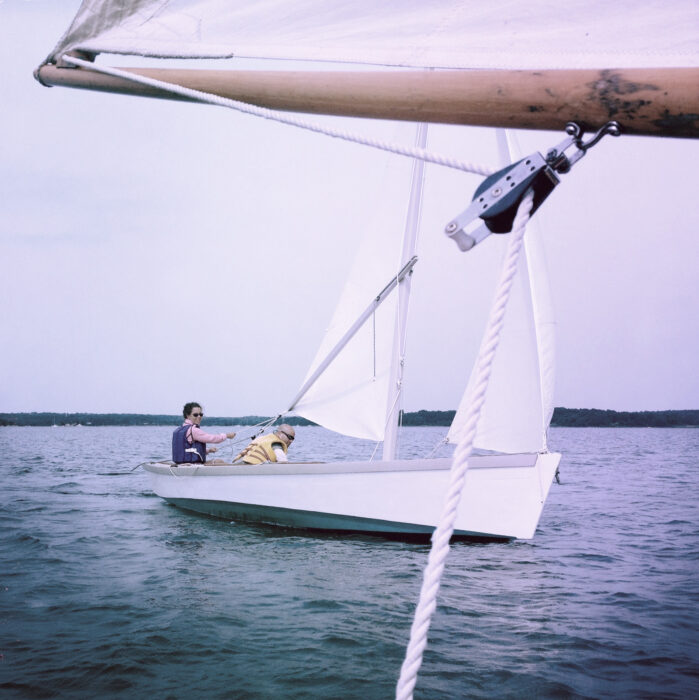 Photographs by Harald Hefel
Photographs by Harald HefelJANIE JANE, seen here in her early days, more than lived up to the sharpie’s reputation for being both fast and seaworthy. Harald often sailed singlehanded, but with her sloop rig there was plenty to do; the open cockpit had more than enough room to bring a crew aboard.
And that’s when the seed of an idea began germinating. Harald decided to turn the old fence rails into a boat. “I talked to a lot of people, including some local Connecticut boatbuilders. I told them I was looking for a simple design to build and sail, and they suggested a sharpie—it was fast and easy to build, and fast on the water.”
He found a design by Reuel Parker: the Sharpie 19, described by Parker as a “half-size reproduction of the sharpie type common to Ohio, the Florida Keys, and East Coast fisheries during the late nineteenth century. The rig is classic.”
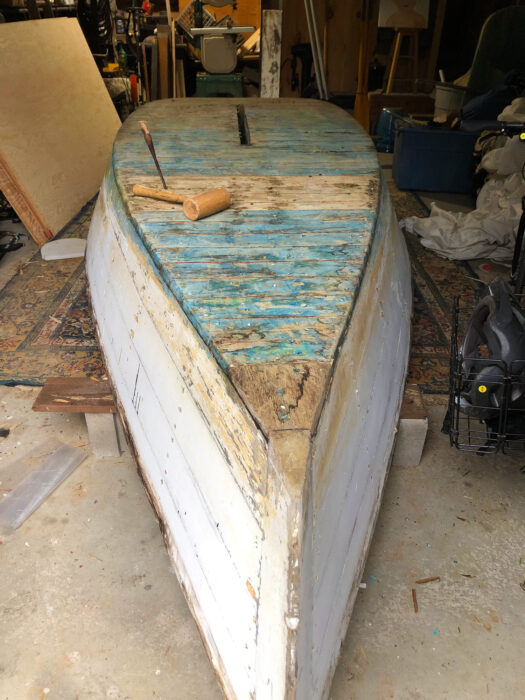
After eight years of sailing and two more of resting on a trailer in the yard, JANIE JANE’s cross-planked spruce bottom was in surprisingly good shape. Harald determined that he could save it if he took it back to bare wood and covered it in polyester cloth and epoxy.
Parker advised building the boat with “cold-molded plywood covered with epoxy-impregnated polyester.” But Harald had all that spruce fencing. He decided to build his sharpie with carvel-planked sides on white-oak frames. In the fall of 2012, he started work on the boat. He ripped and planed the fencerails down from 1″ to 5⁄8″. “It wasn’t ideal, as the thickness didn’t leave much room for a bevel and caulking but 3⁄4″ was too thick to take the bend at the bow.” He cross-planked the bottom using 1×8 spruce boards and built the deck in Douglas-fir wainscoting. He painted the deck and finished the interior with a mix of linseed oil and turpentine.
Harald launched JANIE JANE in 2013 and sailed her for the next eight years until “she was leaking too much, so I brought her ashore and left her in the front yard with the sails up—she became known in the neighborhood as the ‘Yard Schooner.’”

Once work on the bottom was complete and the new topsides were in place, Harald turned JANIE JANE over to work on the interior and deck. He removed the old deck and fitted framing to add a foredeck hatch, which would allow access to the newly designed dry storage and anchor locker.
Within two years, Harald’s longing to be afloat had returned and he started looking for a suitable replacement boat. Then one day in 2023 he walked past JANIE JANE and stopped. “Her foredeck and the topside planking were rotting, but the frames and bottom looked solid, so I decided to rebuild her.”
He moved JANIE JANE into his workshop, set her up on stands, and began the careful process of dismantling her. The original construction had silicon-bronze fastenings, 1,200 total, and he removed them all. He had bedded many of them in tar but, as he removed them, found they were all “a little pinkish and weak, and many of the heads were damaged as they came out.” He determined that they were not suitable for reuse and instead decided to use galvanized screws that would “hold up forever, especially when protected by epoxy.” As he took the planking off the sides, he confirmed that the white-oak frames and spruce bottom had survived the time of standing in the yard collecting rainwater, thanks, he thinks, to the liberal application of linseed oil and turpentine during his sailing years. He flipped the boat upside down, sanded the bottom, cleaned up the outside faces of the frames, and rebuilt the topsides with 3⁄8″ marine plywood.
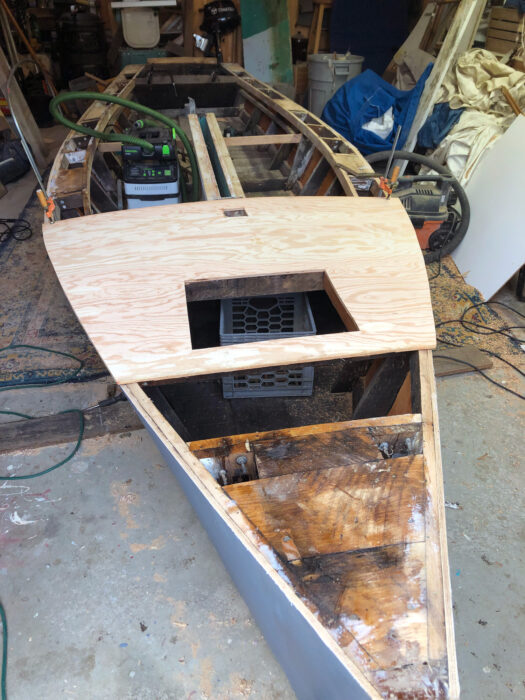
The new deck—3⁄8″ Douglas-fir marine plywood—would, like the hull, be covered with epoxy-saturated polyester cloth.
Before fitting a new deck, Harald constructed two watertight bulkheads for flotation compartments. He installed the first about 5′ aft of the stem, and the other about 20″ forward of the transom. The overall length of the boat is 19′ 6″, and while Harald was eager to introduce the flotation, he also wanted to maintain enough space in the cockpit to accommodate comfortable camp-cruising. The new interior layout, he says, “still gives me room to sleep alongside the centerboard trunk with my feet under the foredeck. That space is about 6′ 6″ long and about 20″ wide, and there’s still plenty of cockpit aft of that.”
The new enclosed compartment beneath the foredeck would double as dry storage. “There’s 18″ of space beneath the foredeck that’s covered but not enclosed, and I use that for storing things I might need during the day; but forward of the bulkhead, in the enclosed compartment, I stow my cooker, food, anchor, shovel and hatchet, kerosene lantern, my 500kW electric motor (which weighs about 14 lbs), and my bedding. Everything stays dry and is not underfoot in the cockpit when I’m sailing. It works great.”
After he had laid the deck, also 3⁄8″ Douglas-fir marine plywood, Harald coated the exterior of the hull and deck in polyester cloth saturated in epoxy. “Polyester was recommended by Reuel Parker, and I loved it. It takes a lot of resin, but it doesn’t itch, it’s really easy to cut, and it conformed to every curve very easily.” He left the interior without a coat of epoxy but, as he had when he first built JANIE JANE, liberally applied a concoction of linseed and turpentine to preserve the wood. “It served her well before,” he says, “and I like the smell. When I sleep on her it’s like sleeping in an old shipyard.”
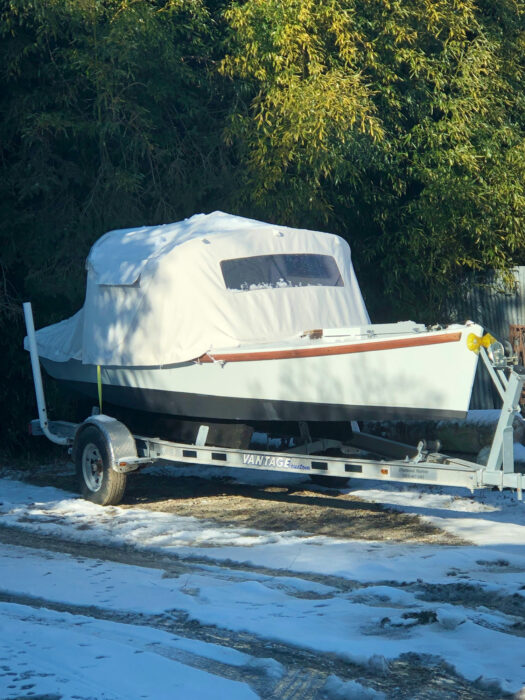
Harald designed and built a tent for JANIE JANE’s new life as a cruiser. He made it in two sections so that it can be deployed over half the cockpit in warmer weather or the whole cockpit on colder or wetter nights.
Like the bottom and the frames, the sailing rig had stood up well. “I made the mast out of construction-grade spruce. It came in 16′ lengths, so I scarfed it with the elongated V of a clothespin scarf to get the required 24′ length. The sprit came from an older sailboat. I was poking around the yard of a shipwright friend, looking for useful material or advice, and told him I needed something suitable for my sprit. He said, ‘How about that?’ and handed me a pole.” Harald had been looking for a 10′ 6″ sprit; his friend’s pole was 10′ 6″. “All I had to do was cut a notch in one end for the snotter and stick a pin in the other end for the clew. It was the perfect match.”
All that was left was for Harald to build the sleeping tent. He designed and constructed a folding frame that collapses to nestle on the foredeck aft of the mast when underway. Built in two sections, the frame can be set up to support canvas over half of the cockpit length for shade or overnight protection in warm weather, or all of the cockpit if the weather is inclement or colder. When raised, the canvas is snap-fastened to the foredeck, and laced along the sides of the boat to hooks tucked beneath the rubrails.
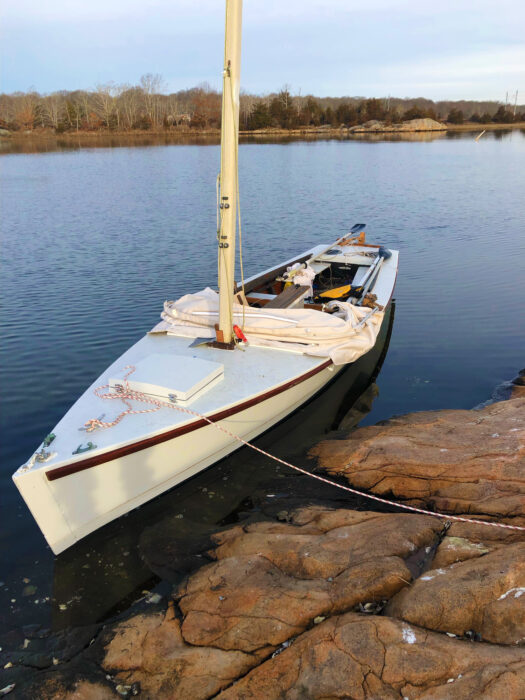
Harald can sail with the tent lowered and resting on the cockpit coaming aft of the mast; at the end of a long sailing day the shelter can be set up quickly and easily. JANIE JANE can be sculled, using the notch mounted on the stern deck, and rowed, with the rower sitting on the aft end of the centerboard trunk.
Harald relaunched JANIE JANE in the spring of 2024 and has since used her extensively for day-sailing and cruising with the Northeast chapter of the North American Group of the UK-based Dinghy Cruising Association (DCA). With no shrouds or stays it takes him about 10 minutes to get her rigged up and ready to go. She rows very well, he says, although he did reposition the oarlocks. As built back in 2012, they were “a good foot aft of the centerboard trunk. I moved them forward, so they are even with the aft end of the trunk, which I sit on, and it’s much better for the trim.” All up, JANIE JANE weighs about 1,100 lbs—considerably more than the estimated 325-lb weight of the boat if built cold-molded—and Harald says it takes some effort to get going under oars, but “once she starts, she’s easy to row and carries her way with style.”
Under sail she’s even more impressive. “I once overhauled a Bayraider 20 to windward,” Harald reports with pride. “The skipper said he’d never underestimate a sharpie again!” For the most part, Harald sails alone with just his miniature dachshund, Trapper John MD (Trapper for short), for crew. Together they have been stalwart participants of many of the DCA cruises on the Connecticut River, around Narragansett, and in Long Island Sound, and the sharpie is the perfect boat for longer expeditions.
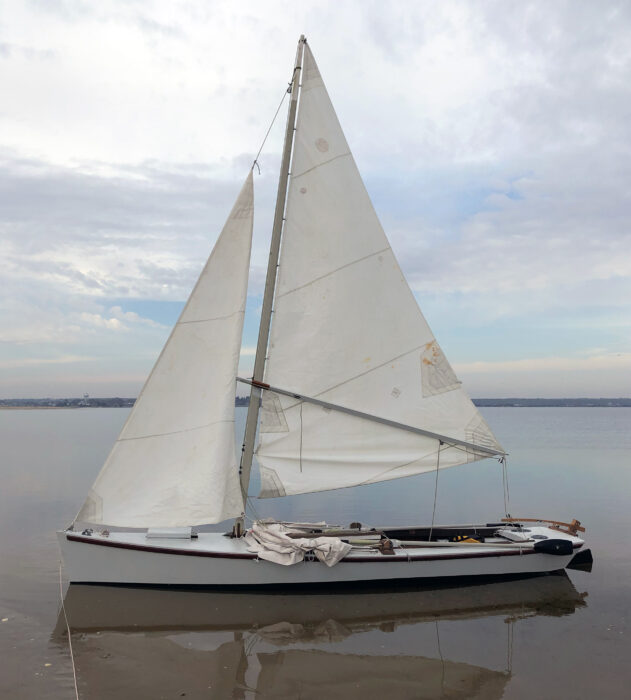
While the topsides, decks, forward and after flotation compartments, and framed camping tent are new, JANIE JANE’s overall appearance is as ever—a simple, sleek, no-nonsense sharpie.
But for daysailing, Harald concedes that JANIE JANE is on the heavy side. “I want something smaller and lighter for our short trips,” he says. “Around 15′ and under 300 lbs.”
So, Harald has returned to the workshop. He’s found what he thinks will be the perfect boat: “The Mississippi Sharpie is another of Reuel Parker’s designs. This time around I’m building with plywood and epoxy. If build it right, it’ll weigh less than 200 lbs. I hope to have it ready to take to Georgia for the winter. Then Trapper and I can have fun exploring the coast down there.”
For now, JANIE JANE is laid up for the winter, but she’ll be back out next year for more camp-cruising in style.![]()
Jenny Bennett is managing editor of Small Boats.
Do you have a boat with an interesting story? Please email us. We’d like to hear about it and share it with other Small Boats readers.


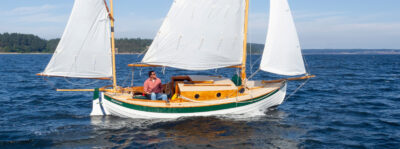
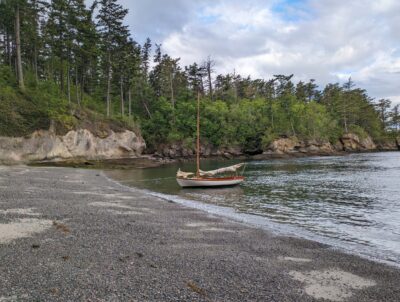


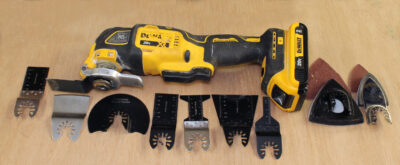
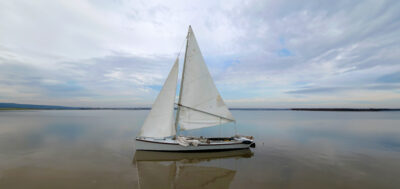
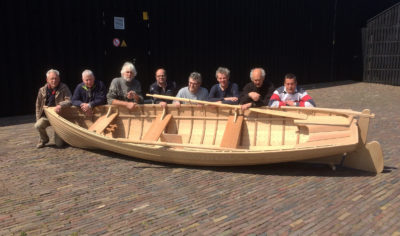
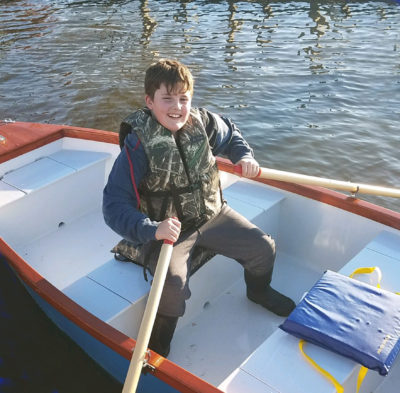
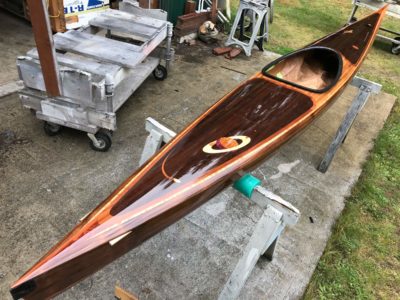

Go Harold!
Here in Alaska the mantra is light, lighter, lightest. The plywood build mentioned by the author fits the bill.
Great job!
But ”500KW electric motor”? That seems a bit exaggerated for this vessel.